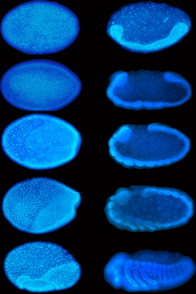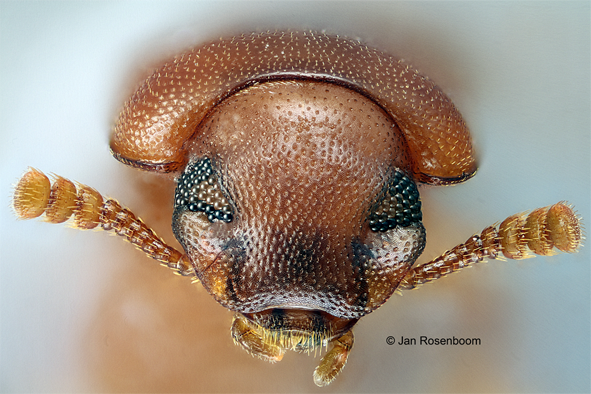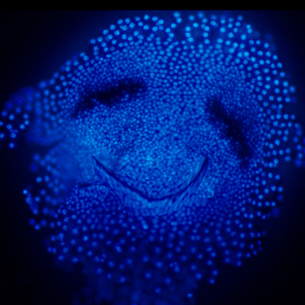The red flour beetle Tribolium castaneum belongs to the family of darkling beetles and causes the massive loss of stored grain products around the world. In that respect, Tribolium has an enormous negative impact on human economics.
Our current work is focussed on the analysis of developmental processes of this insect.
As a short germband insect, Tribolium displays many features typical for most arthropods and vertebrate embryos.
By studying appendage formation, head development and axis elongation, we gain general insights into how embryos develop.
more ...
Schröder R, Beermann A, Wittkopp N, Lutz R 2008 From development to biodiversity - Tribolium castaneum, an insect model organism for short germband development. Dev Genes Evol 218:119-126 (Review)
Beermann A, Wittkopp N, Lutz R & Schröder R 2006 Von der Evolution musterbildender Prozesse zum Verständnis morphologischer Vielfalt. BIOSpektrum 3/06 (Überblick)
Beetle Embryogenesis

How an embryo forms within an egg is a fascinating process.
In the fly Drosophila, the segmentation gene hierarchy leads to the subdivision of the larva into iterated units, the segments. During the blastoderm stage of a Drosophila embryo, all segments develop nearly simultaneously which is called the long germband mode.
In contrast, in the blastoderm embryo of the flour beetle Tribolium only few body segments have formed showing the type of a short germband embryo. The remaining body segments along the anterior-posterior axis are added sequentially later during embryogenesis that involves the posterior growth zone tissue. Short germband development is a representative type of embryogenesis and occurs in most Arthropods and in vertebrates.
We are interested how different signal transduction pathways (Wnt, Fgf) direct body axis elongation, limb development and head formation.
To understand these processes we combine RNA-interference with expression analyses of marker genes, live imaging and electron microscopy.
Head Development
The early...
... specification and the subsequent development of the insect head and its segments is a fascinating field in developmental biology. In Drosophila, the morphogen bicoid organizes patterning of the head and the thorax. However, bicoid is an evolutionary novelty of higher dipterans and absent from the genome other arthropods.
We have shown that the homeodomain protein orthodenticle (otd) is substituting for some functions of bicoid during embryogenesis of the beetle Tribolium. The exact mechanism of otd involved in head segmentation of Tribolium is however not understood.
OTD-RNAi video-1
Key publications
Schröder R (2003) The genes orthodenticle and hunchback substitute for bicoid in the beetle Tribolium. Nature 422, 621 – 625
Schröder R & Sander K (1993) A comparison of transplantable bicoid activity and partial bicoid homeobox sequences in several Drosophila and blowfly species (Calliphoridae). Roux' s Arch. Dev. Biol. 203, 34-43
Limb Development
The variety...
... of insect appendages is endless. In fact, morphological features of antennae, mouthparts, and legs serve to distinct one species from the other. Yet, the developmental program of setting up the proximo-distal (PD) axis of an appendage is highly conserved. We want to understand the genetic basis of how limbs between species became different during evolution. We therefore analyse the genetic network of setting up the PD axis in the short germband model organism Tribolium castaneum. As in most other arthropods, Tribolium limbs elongate continuously during embryogenesis from a limb bud, similarly as in vertebrates. The Sp8 gene is required for stretching the proximo-distal axis in Drosophila, Tribolium and the mouse. This implies that Sp8 is part of the essential genetic toolkit for animal development.
Key publications
Beermann A, Prühs R, Lutz R, Schröder R. 2011 A context-dependent combination of Wnt receptors controls axis elongation and leg development in a short germ insect. Development. 138, 2793-2805.
Beermann A & Schröder R (2004) Functional stability of the aristaless gene in appendage tip formation during evolution. Dev Genes Evol 214, 303-308
Beermann A , Aranda M & Schröder R (2004) The Sp8 zinc-finger transcription factor is involved in allometric growth o fthe limbs in the beetle Tribolium castaneum. Development 131, 733 – 742
Axis elongation ...
Axis elongation
... in a short germband embryo is regulated by a tissue at the posterior of the embryo, called the growth zone or the tail bud. In the growth zone, multiple pathways such as Ras/Raf signaling and the WNT (panel a) - and FGF- signaling pathways (panel b (blue) in relation to twist-expression (red)) are involved in embryonic patterning. We currently characterise the gene regulatory networks of the growth zone and the cellular architecture of this proliferative tissue. Specifically, we are interested in the gene regulatory networks that specify the growth zone, that maintain axial growth and that are involved in terminating the activity of the growth zone. By applying high-resolution microscopy we aim for the understanding of this tissue at the cellular level.
Key publications
Beermann A, Prühs R, Lutz R, Schröder R. 2011 A context-dependent combination of Wnt receptors controls axis elongation and leg development in a short germ insect. Development. 138, 2793-2805.
Beermann A & Schröder R (2008) Sites of Fgf signalling and perception during embryogenesis of the beetleTribolium castaneum. Dev Genes Evol 218, 153-167
Bolognesi R, Beermann A, Farzana L, Wittkopp N, Lutz R, Balavoine G Brown S & Schröder R (2008) TriboliumWnts: evidence for a larger repertoire in insects with overlapping expression patterns that suggest multiple redundant functions in embryogenesis. Dev Genes Evol 218, 193-202




